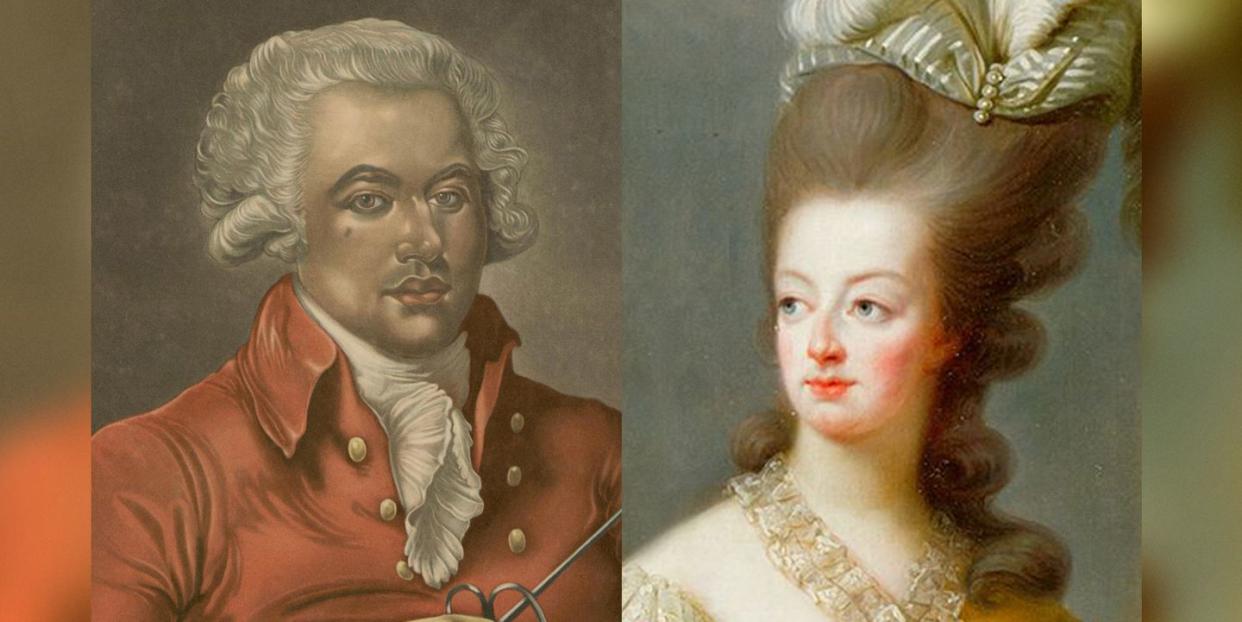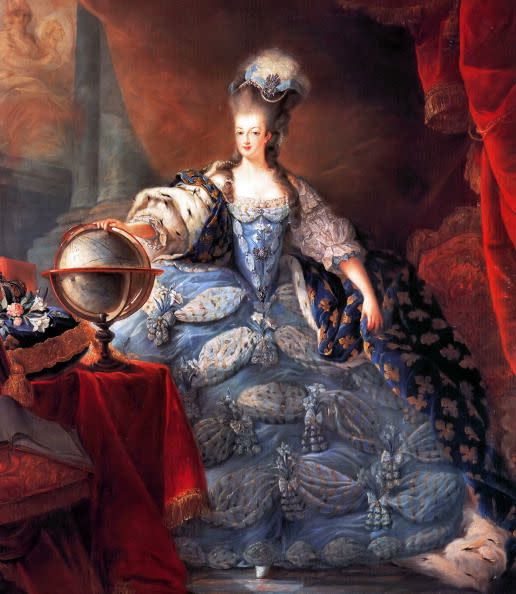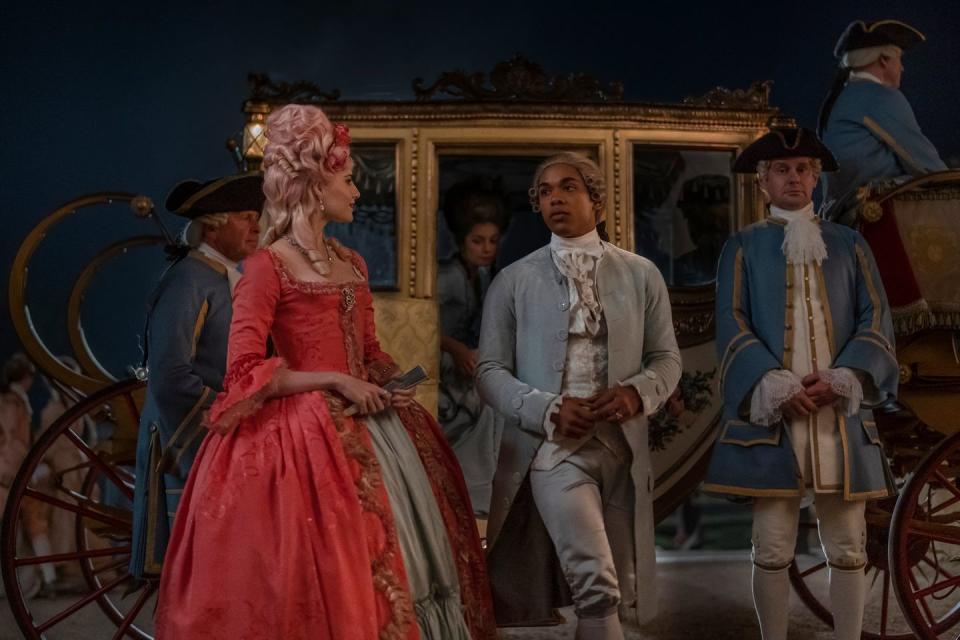The Truth About Marie Antoinette and Chevalier de Saint-Georges

- Oops!Something went wrong.Please try again later.
- Oops!Something went wrong.Please try again later.
Chevalier de Saint-Georges is the subject of the new film Chevalier, and his fascinating life is long overdue for some silver-screen attention. The 18th century composer was a violin virtuoso, master fencer, military leader, orchestra conductor, and crafter of symphonies so impressive that he is often referred to as the “Black Mozart.”
Despite his incredible life and achievements, Saint-Georges’ story has largely been forgotten. In his own day, however, his talents captured the idea of a particular notable patron: Marie Antoinette. She so admired his work that she invited Saint-Georges for private performances, which raised more than a few eyebrows among her royal court.
Saint-Georges’ connection to Marie Antoinette is featured heavily in the trailer for Chevalier, now in theaters, and is one of the most remembered aspects of his life. His association with the queen brought him greater prominence but had its fair share of drawbacks as well. This is the story of their relationship, from their intimate musical performances together to how their perceived closeness later hurt him during the French Revolution.
Who Was Chevalier de Saint-Georges?
Born on Christmas Day in 1745, Joseph Bologne was the son of a French nobleman, who had a court appointment in the royal household, and his slave mistress, who was of Senegalese descent. Bologne was educated in France and excelled at fencing, defeating master fencers even during his teenage years. He was a chevalier, or knight, and adopted the name Chevalier de Saint-Georges. The suffix came from the name of his father’s plantation.
But Saint-Georges’ true gifts were in music. His skills at violin and harpsichord earned him the attention of such major composers as Antonio Lolli, Jean-Marie Leclair, and François-Joseph Gossec. By 1769, Saint-Georges joined Gossec’s symphony orchestra Le Concert des Amateurs. He was later appointed the orchestra’s concertmaster and started composing his own works.
Saint-Georges wrote celebrated violin concertos, several hit operas, and was one of the first French composers to write for a string quartet, according to WCRB. As a conductor, he commissioned the legendary Joseph Haydn to write six symphonies for him. Saint-Georges lived in Paris the same time as Mozart and was actually more famous than him at the time.
“Chevalier was unfairly called the ‘Black Mozart,’ it should really be in many cases Mozart who should be called the ‘White Chevalier,’” said Bill Barclay, a composer and music director who wrote a play about Saint-Georges.
Catching the Eye of Marie Antoinette

Marie Antoinette had an appreciation for music instilled in her since her childhood, when her mother, the Holy Roman Empress Maria Theresa, insisted she received voice, harp, and piano lessons as part of her education, according Chevalier de Saint-Georges: Virtuoso of the Sword and the Bow, a biography by Gabriel Banat.
After she became queen of France, Marie Antoinette began hosting intimate musicales in her private apartments at the Palace of Versailles. She preferred a small audience, so these gatherings were largely limited to a few musicians and a small number of guests from her immediate entourage. Saint-Georges was among the participants, Banat wrote.
Saint-Georges likely played the piano during these musicales, with Marie Antoinette joining him on the forte-piano, according to Europeana. Marie Antoinette also attended Saint-Georges’ more public concerts in Paris at places like Hôtel de Soubise and the Tuileries Palace.
In fact, Marie Antoinette dropped by these performances often enough, without providing notice in advance, that the orchestras got into the habit of wearing their formal court attire for each concert, just in case she happened to show up, according to Banat.
Getting “Too Close” to the Queen

The relationship between Marie Antoinette and Saint-Georges was a ripe subject for gossip in the royal court. According to Classic FM, their musicales came to an end because they became “too close.” It was not lost on observers at the time that Saint-Georges had a reputation as a charming ladies’ man.
In describing his performances with the queen, the gossipy French writer Louis Petit de Bachaumont called Saint-Georges a “most valiant champion of love and sought out by all the women aware of all his marvelous talents, in spite of the ugliness of his countenance,” according to Banat. “Describing him as a champion lover and then referring, in the same breath, to his making music with the queen seems a low blow even from that catty diarist,” Banat wrote.
Saint-Georges’ relationship with Marie Antoinette harmed his career in other ways beyond idle gossip, however. In 1775, he was a candidate to become director of the Paris Opera, which caused an uproar among theater officials and opera singers at the time who opposed him due to his mixed race, according to Stefan Goodwin, author of Africa in Europe.
When these artists petitioned Marie Antoinette to deny him the position, the queen’s fondness for Saint-Georges proved to be a liability for him, not an asset. He ultimately withdrew his name from consideration “out of respect for Marie Antoinette, so not to embarrass her,” Barclay said.
Serving the Revolution, Then Becoming Its Victim
Despite his impressive career and accomplishments, Saint-Georges was subjected to racist attacks and insults throughout his life. In fact, Goodwin wrote that in 1779, Saint-Georges was attacked by six undercover police officers while leaving the Palace of Versailles, after having just finished a performance there at Marie Antoinette’s request.
Sensitive to such discrimination, Saint-Georges supported the Declaration of the Rights of Man and of the Citizen, drafted by the Marquis de Lafayette during the French Revolution. Saint-Georges also led a cavalry unit of more than 1,000 Black volunteer soldiers in defense of the Revolution in 1792.
Despite this, his relationship with Marie Antoinette came back to haunt him again, even after she was beheaded in 1793. Anyone with close ties to the aristocracy fell under suspicion during the Revolution’s period of violence known as the Reign of Terror, and Saint-George was condemned for having once been friendly with the deceased queen.
Saint-Georges spent nearly a year in prison on charges of supporting non-revolutionary activities, according to Banat. He was released in 1794, but he died destitute in Paris five years later, at age 55, of bladder cancer. Much of the music he composed was lost during the French Revolution, and his remarkably accomplished life was largely forgotten to history until recently.
See Chevalier in Theaters Now
Chevalier stars Kelvin Harrison Jr. in the title role and Samara Weaving as Marie Antoinette. The Searchlight Pictures film is now playing in theaters.

